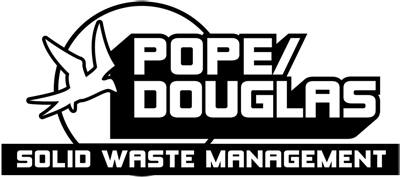Business Recycling
Recycling at your place of business is not only good for the environment, but can improve your image to your customers.
Building an effective and successful recycling program is no sweat!
5 Steps to Better Business Recycling
Business recycling is easier than you think. Use this step-by-step guide to help you design a program that is tailored to meet the needs of your business. If your business has already established a program, look here for ideas on how to improve or expand your program.
Single Sort Recycling List of Items Accepted.
Contact Pope/Douglas for more information on the Competitive Business Recycling Grants Program. We have the resources to set your business up with color-coded bins, signs and stickers to make recycling at your business a breeze!
Step 1: Get Organized
Business waste and recycling programs succeed when employees and management are engaged, involved and committed.
Employees: Get management on board by showing how a waste reduction and recycling program can save your your company money, boost employee morale and save natural resources.
Management: Identify a ‘champion’ in your organization to lead the effort, coordinate activities, and keep people informed and engaged in the process.
Step 2: Look In The Bin
Recycling is tax exempt in Minnesota. Take a look in the trash bins around your office – you might be throwing away money!
This is not a time to shame employees or management, but rather, an opportunity to assess opportunities to improve.
Employees: Take a look at the trash and recycling bins around your office and take note of the following:
- Are they full?
- What’s in them? Are there recyclables in the trash and vice versa? How much of your garbage is food waste and soiled non-recyclable papers (like napkins and paper plates)?
- How often is your trash and/or recycling picked up?
Management: Review your trash and recycling service (waste hauler) statements or talk to them to evaluate:
- How much waste is your business generating?
- How much does your collection and disposal services cost?
- Where is your waste going and how is it managed?
Managing and Reducing Wastes: A Guide for Commercial Buildings
Step 3: Reduce Waste
Waste reduction can lower costs in every area of your business – from your break rooms to the shipping dept.
Employees: A few simple changes can significantly reduce the amount of waste you create at work:
- Use both sides of a sheet of paper when printing and copying
- Use reusable dishware in break room and at your desk
- Use electronic documents whenever possible and print only what you need
Management: Brainstorm with staff about your day-to-day operations to help identify waste reduction opportunities. Some potential area include:
- Buying supplies in bulk or economy sized packaging
- Purchasing or leasing washable cleaning cloths
- Shipping products in returnable containers
The Minnesota Technical Assistance Program (MnTAP) is a resource to reducing waste, recycling more and managing business hazardous waste effectively.
Step 4: Start Recycling
Recycling is easy when done right!
Employees: Make sure you’re getting the most out of the recycling program where you work:
- Verify what’s being accepted with your service provider
- Place clear and visible labels on every recycling bin
- Place a recycling bin next to every trash can
- Work with facility staff to make sure recycling is being collected and stored properly for pick-up
Management: Comparison shop for a recycling hauler. Key questions to ask potential recycling haulers include:
- What materials do you collect and how should they be prepared/sorted?
- Do you provide collection containers (desk recycling bins, barrels, dumpsters or outside storage containers?
- Do you provide labels or signs to encourage recycling and reduce contamination of trash going in the recycling container and vice versa?
- What are your payment terms? Do you require a contract for service?
Free downloadable posters, signs and stickers to help educate your waste and recycling programs.
Contact Pope/Douglas today!
Color coding containers and signs helps reinforce what goes into which bin.
Step 5: Spread The News
Step 5: Spread the News
Employee participation and training is critical to success!
Spread the news about your recycling efforts.
Employees: Spread the word to your fellow employees about your company’s recycling program. Be sure to include information on company goals, what’s recyclable and who to contact with questions.
Management: Coordinate training for everyone in your company that handles recyclables, from custodial staff to outside contractors. Program understanding at every level is critical to its success. Track your progress and celebrate success!
Recycling Matters!
- You’ve just saved materials. Instead of going to a landfill or incinerator, that bottle or can will gain new life as a new bottle, can or other object.
- You’ve saved energy. It takes less energy to create new products out of collected recyclables compared to making products from virgin resources.
- You’ve saved a trip to the oil well, mine or gas field. Because you reused the material in step one, there isn’t a growing need to extract resources from the oil well head or mine shaft in order to get more stuff out of the earth.
- You’ve preserved habitat. Face it- no matter how carefully done, mining and oil drilling creates habitat damage. Using less saves habitat and our natural systems.
- You’ve created jobs. Recycling requires people to do it. Repairing or refurbishing old equipment requires labor. By reusing, restoring and recycling, you create green jobs for the people who do the work.
- You’ve improved national security and saved lives. By recycling, you’ve reduced the demand for virgin resources, while increasing the demand and value for resources we already have.
- You feel better about yourself. You’re a responsible citizen who’s making a better world for all of us.
